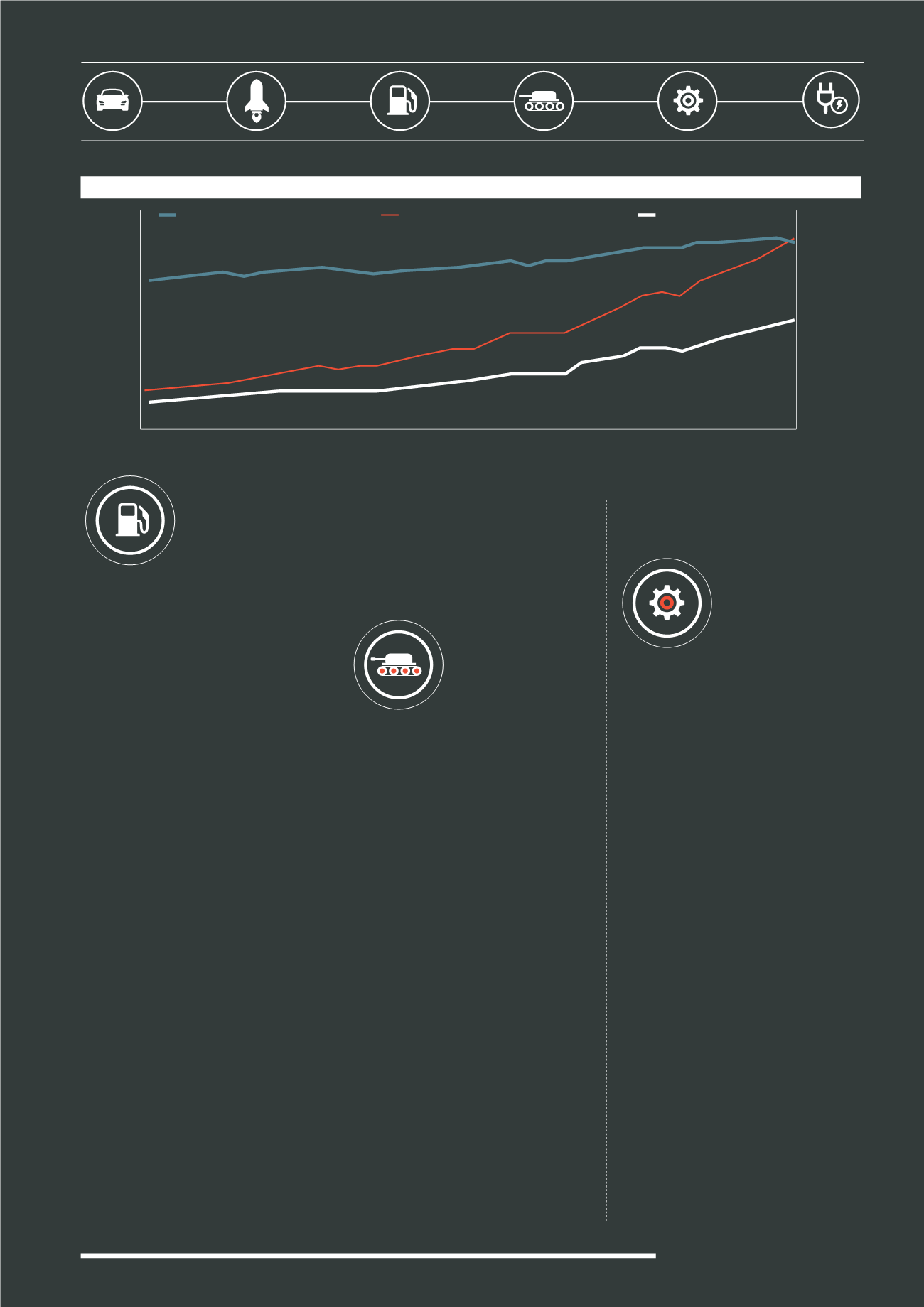
17
OIL&GAS
There were 1,100 companies achieving
combined revenues of £27 billion in
2011 in the UK Oil and Gas sector
2
and
global exports of oil and gas equipment
and services equate to around £6 billion
each year which is larger than total UK
exports to Brazil.
8
Despite the recent dip in oil prices,
which was initiated in July 2014 as a
result of an oil surplus on the world
market, “Engineering is the driving
force in the energy extraction and
supply industry. North Sea oil and gas
is one of the UK’s greatest success
stories, providing a vital boost to the
economy over the last five decades.
The UK has developed world-leading
expertise in engineering fields related
to energy and resources, from deep-
sea drilling to specialised construction
and steelmaking. Through successful
investment in engineering, the sector
has partially mitigated declining revenue
from extraction as reserves decline.”
8
Oil price uncertainty is clearly
affecting the surrounding industries
and Precision Engineers who are
not diversified across other sectors,
using their knowledge and machinery
to take advantage of the booms in
those sectors, may well experience
difficulties. Nevertheless, suppliers
of Precision Engineered components
have a critical role in meeting the
demand for environmentally and safety
compliant products to prevent spills and
accidents that are damaging financially
and ecologically and this gives them
the opportunity to secure long-term
positions in the drilling supply chain.
23
DEFENCE
With an annual turnover of £35bn,
the UK is the world’s second biggest
defence exporter behind the USA.
The sector employs 300,000 overall in
the UK, including BAE Systems – the
UK’s largest defence company, which
currently employs 40,000 domestically.
Since 10% of UK manufacturing is made
up by defence, it is clearly an important
sector to suppliers.
31
£13.1 billion of UK manufactured
military products were sold in 2013,
however, although public spending on
defence increased from £33.3 billion
to £41.3 billion (by 24%) between the
2001/02 and 2010/11 financial years,
defence spending has fallen every
year since 2010/11, to £36.4 billion in
2013/14
32
. This makes export markets
increasingly important, but with nations
including Russia, Latvia, Lithuania and
Poland planning dramatic increases to
arms spending, China, and Saudi Arabia
substantially increasing their military
spending, and the US still the world’s
largest spender on arms despite a 20%
cut in its defence budget since its peak
in 2010
33
, there is capacity for expansion
with the right products.
METALS
This sector is important as it provides
the material which is most often used
by Precision Engineers. This includes
steel and non-ferrous metals such as
aluminium and titanium. Metals are
a vital building block for the largest
buildings to the smallest components
and creating, shaping and maintaining
machinery to create and use them,
comes into the domain of Precision
Engineers: In 2013, the UK demand for
steel was at 9.6 million tonnes
34
and
the machinery used to produce it has
to withstand high temperatures and
constant use; UK Precision Engineers
play a major role in ensuring that the
mills that produce the metals are able
to do so day after day. Steel is of great
importance to the UK economy and
everyday life and according to the EEF,
which represents the UK steel industry,
“Just about everything we use either
contains steel or has been made using
steel. Whether it is bolts or buildings,
clothes or chemicals, food or fast cars,
lamps or lemonade, all depend on
steel at some point.” Although UK steel
production declined in the ten years to
2013, global steel consumption rose by
68%
35
.
GLOBAL AIRLINE TRAFFIC
30
(1981-2015)
1981
1982
1983
1984
1985
1986
1987
1988
1989
1990
1991
1992
1993
1994
1995
1996
1997
1998
1999
2000
2001
2002
2003
2004
2005
2006
2007
2008
2009
2010
2011
2011
2012
2013
2014
2015
7
6
5
4
2
3
1
0
90%
80%
70%
60%
40%
50%
30%
20%
10%
0%
Number of passengers (in millions) and
revenue passenger kilometres
Passenger load factor percentage
Passenger load factor percentage
Passengers (millions)
Revenue passenger kilometres (millions)


